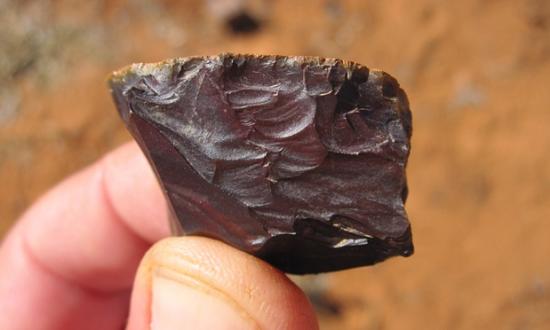Archaeological survey by state’s Department of Aboriginal Affairs identified no Aboriginal material at Bibra lake north site in Perth, despite 1970s study that uncovered more than 2,000 artefacts
Source - http://www.theguardian.com/australia-news/2015/sep/23/indigenous-site-older-than-pyramids-in-perth-freeways-path-taken-off-heritage-register
 A piece of chert similar to the ancient artefacts that were discovered near Bibra lake. Photograph: UWA Archaeology/AAP
A piece of chert similar to the ancient artefacts that were discovered near Bibra lake. Photograph: UWA Archaeology/AAP
A Western Australian government advisory committee has deregistered an Aboriginal heritage site that is “older than the pyramids” and reversed its previous opposition to a proposed freeway which will overlap the site.
The site is on the northern banks of Bibra lake, about a 20-minute drive south of the Perth CBD, and under the path of the proposed Roe 8 freeway extension. Construction is scheduled to begin next year as part of the first leg of the $1.6m Perth Freight Link.
The site was taken off the Aboriginal heritage register by the Aboriginal cultural materials committee (ACMC), part of the Department of Aboriginal Affairs, in June, because an archaeological survey conducted by the department found no Aboriginal cultural material.
At that same meeting, the committee reversed its previous decision not to grant heritage clearance for the proposed freeway works.
An archaeological survey conducted in the 1970s found the Bibra lake north site contained more than 2,000 artefacts, including some made of clay, quartz, glass and a fossil-containing type of sedimentary rock called chert. It is the last material that is of particular significance, according to WA Greens MP, Lynn MacLaren.
MacLaren said the fossiliferous chert could only have been obtained during the last ice age, at least 6,000 years ago, from land that has since become the seabed – which means the site itself is at least 5,000 years old.
“Allowing 1,000 years for those chert artefacts being in reuse, it is a clear indication that the site has been in use at least 5,000 years and, given the glass artefacts, made since European arrival, the site clearly has been in continuous use by Aboriginal people for at least 5,000 years,” she said.
“This site is older than the pyramids and has been around longer than western civilisation.”
The site is one of 11 removed from the register since April, when a landmark judgment in the supreme court found the ACMC was misconstruing the Aboriginal Heritage Act in its definition of what constituted a “sacred site”. A further 22 sites were removed in the 21 months before the court decision.
The site assessment by two department-employed archaeologists in March 2014 was tabled last week in parliament. It found the site had “been subjected to high amounts of disturbance” from existing roadworks and “no Aboriginal cultural material was identified within the site boundaries”.
A pit dug to a depth of 20cm also found no Aboriginal cultural material, the report said.
But it noted: “An in-depth archaeological excavation program may establish the presence of an intact subsurface deposit below the level of disturbance which was beyond the scope of the inspection visit.”
MacLaren described the inspection as “cursory” and “gobsmackingly inadequate”, and said that it should have involved a more complete archaeological survey and input from traditional owners.
“From speaking to archaeologists, I understand at least 20 shovel pits, each to a depth of a metre, should have been done,” she said.
MacLaren has also objected to the ACMC’s decision to grant heritage clearance to the Roe 8 freeway extension, despite rejecting it the first time around.
The site mentioned in that decision was DA3709 – an ethnographic or sacred site covering an area between Bibra and North lakes, which in Noongar culture is the birthplace of the creation spirit Waugyl, the serpent that created Perth waterways such as the Swan and Canning rivers. It is still registered.
The South West Land and Sea Council, which represents the Noongar people in native title and heritage claims, has repeatedly voiced its opposition to the proposed freeway.
Minutes of the ACMC’s meeting in February 2013, which were tabled in parliament, recommended that consent for the road construction should not be granted, “based on the ethnographic significance of the sites, the subject of the notice, and the objections to the purpose raised by the majority of the Aboriginal [sic] consulted”.
But the minutes of its meeting in June recommended “that consent with conditions be granted, noting that the applicant has indicated that the purpose will be designed and constructed in a manner to minimise the road footprint and impact on Aboriginal sites and places”.
The Aboriginal affairs minister, Peter Collier, said the department had asked ACMC to reconsider the Roe 8 heritage application on the basis of new archaeological information about three sites, including the Bibra lake north site that has since been deregistered.
Speaking in parliament on Thursday, Collier said he had to “have regard to the general interest of the community” when considering Aboriginal heritage recommendations. But he said: “I understand and recognise the importance and significance of the North lake and Bibra lake area to the traditional owners.”